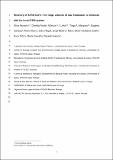Files in this item
Recovery of SARS-CoV-2 from large volumes of raw wastewater is enhanced with the inuvai R180 system
Item metadata
| dc.contributor.author | Monteiro, Silvia | |
| dc.contributor.author | Rente, Daniela | |
| dc.contributor.author | Cunha, Mónica V | |
| dc.contributor.author | Marques, Tiago A | |
| dc.contributor.author | Cardoso, Eugénia | |
| dc.contributor.author | Álvaro, Pedro | |
| dc.contributor.author | Vilaça, João | |
| dc.contributor.author | Ribeiro, Jorge | |
| dc.contributor.author | Silva, Marco | |
| dc.contributor.author | Coelho, Norberta | |
| dc.contributor.author | Brôco, Nuno | |
| dc.contributor.author | Carvalho, Marta | |
| dc.contributor.author | Santos, Ricardo | |
| dc.date.accessioned | 2022-12-15T00:38:38Z | |
| dc.date.available | 2022-12-15T00:38:38Z | |
| dc.date.issued | 2022-02-15 | |
| dc.identifier | 277198740 | |
| dc.identifier | 1a0143a4-4216-46a6-8861-add6f26ae0e9 | |
| dc.identifier | 34923418 | |
| dc.identifier | 85121215153 | |
| dc.identifier | 000741771500001 | |
| dc.identifier.citation | Monteiro , S , Rente , D , Cunha , M V , Marques , T A , Cardoso , E , Álvaro , P , Vilaça , J , Ribeiro , J , Silva , M , Coelho , N , Brôco , N , Carvalho , M & Santos , R 2022 , ' Recovery of SARS-CoV-2 from large volumes of raw wastewater is enhanced with the inuvai R180 system ' , Journal of Environmental Management , vol. 304 , 114296 . https://doi.org/10.1016/j.jenvman.2021.114296 | en |
| dc.identifier.issn | 0301-4797 | |
| dc.identifier.other | ORCID: /0000-0002-2581-1972/work/105318169 | |
| dc.identifier.uri | https://hdl.handle.net/10023/26596 | |
| dc.description | This work was funded by Programa Operacional de Competitividade e Internacionalização (POCI) (FEDER component) and Programa Operacional Regional de Lisboa (Project COVIDETECT, LISBOA-01-02B7-FEDER-048467). Strategic funding of Fundação para a Ciência e a Tecnologia (FCT), Portugal, to cE3c,BioISI and CEAUL Research Units (UIDB/00329/2020, UIDB/04046/2020 and UIDB/00006/2020) is gratefully acknowledged. | en |
| dc.description.abstract | Wastewater-based epidemiology (WBE) for severe acute respiratory syndrome Coronavirus 2 (SARS-CoV-2) is a powerful tool to complement syndromic surveillance. Although detection of SARS-CoV-2 in raw wastewater may be prompted with good recoveries during periods of high community prevalence, in the early stages of population outbreaks concentration procedures are required to overcome low viral concentrations. Several methods have become available for the recovery of SARS-CoV-2 from raw wastewater, generally involving filtration. However, these methods are limited to small sample volumes, possibly missing the early stages of virus circulation, and restrained applicability across different water matrices. The aim of this study was thus to evaluate the performance of three methods enabling the concentration of SARS-CoV-2 from large volumes of wastewater: i) hollow fiber filtration using the inuvai R180, with an enhanced elution protocol and polyethylene glycol (PEG) precipitation; ii) PEG precipitation; and iii) skimmed milk flocculation. The performance of the three approaches was evaluated in wastewater from multiple wastewater treatment plants (WWTP) with distinct singularities, according to: i) effective volume; ii) percentage of recovery; iii) extraction efficiency; iv) inhibitory effect; and v) the limits of detection and quantification. The inuvai R180 system had the best performance, with detection of spiked control across all samples, with average recovery percentages of 68% for porcine epidemic diarrhea virus (PEDV), with low variability. Mean recoveries for PEG precipitation and skimmed milk flocculation were 9% and 14%, respectively. The inuvai R180 enables the scalability of volumes without negative impact on the costs, time for analysis, and recovery/inhibition. Moreover, hollow fiber ultrafilters favor the concentration of different microbial taxonomic groups. Such combined features make this technology attractive for usage in environmental waters monitoring. | |
| dc.format.extent | 7 | |
| dc.format.extent | 316185 | |
| dc.language.iso | eng | |
| dc.relation.ispartof | Journal of Environmental Management | en |
| dc.subject | RA0421 Public health. Hygiene. Preventive Medicine | en |
| dc.subject | TD Environmental technology. Sanitary engineering | en |
| dc.subject | NDAS | en |
| dc.subject | SDG 3 - Good Health and Well-being | en |
| dc.subject | AC | en |
| dc.subject.lcc | RA0421 | en |
| dc.subject.lcc | TD | en |
| dc.title | Recovery of SARS-CoV-2 from large volumes of raw wastewater is enhanced with the inuvai R180 system | en |
| dc.type | Journal article | en |
| dc.contributor.institution | University of St Andrews. School of Mathematics and Statistics | en |
| dc.contributor.institution | University of St Andrews. Scottish Oceans Institute | en |
| dc.contributor.institution | University of St Andrews. Centre for Research into Ecological & Environmental Modelling | en |
| dc.identifier.doi | https://doi.org/10.1016/j.jenvman.2021.114296 | |
| dc.description.status | Peer reviewed | en |
| dc.identifier.url | https://www.medrxiv.org/content/10.1101/2021.07.21.21260907v1.article-info | en |
| dc.identifier.url | https://www.ncbi.nlm.nih.gov/pmc/articles/PMC8673751/ | en |
This item appears in the following Collection(s)
Items in the St Andrews Research Repository are protected by copyright, with all rights reserved, unless otherwise indicated.

